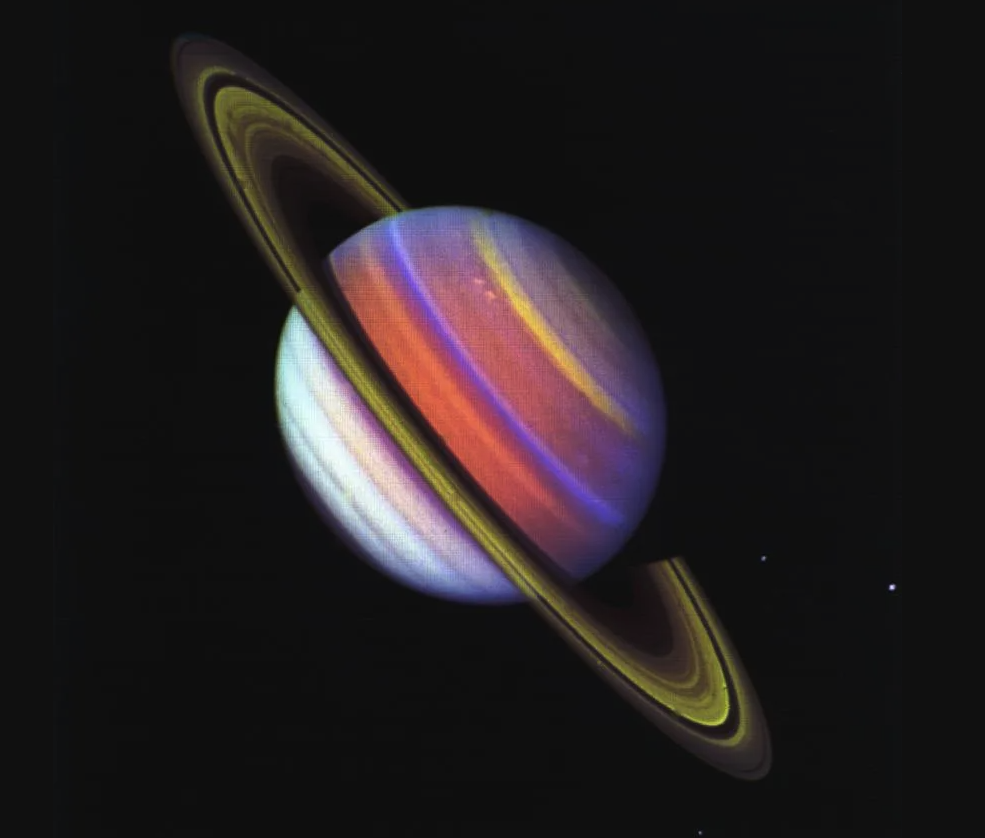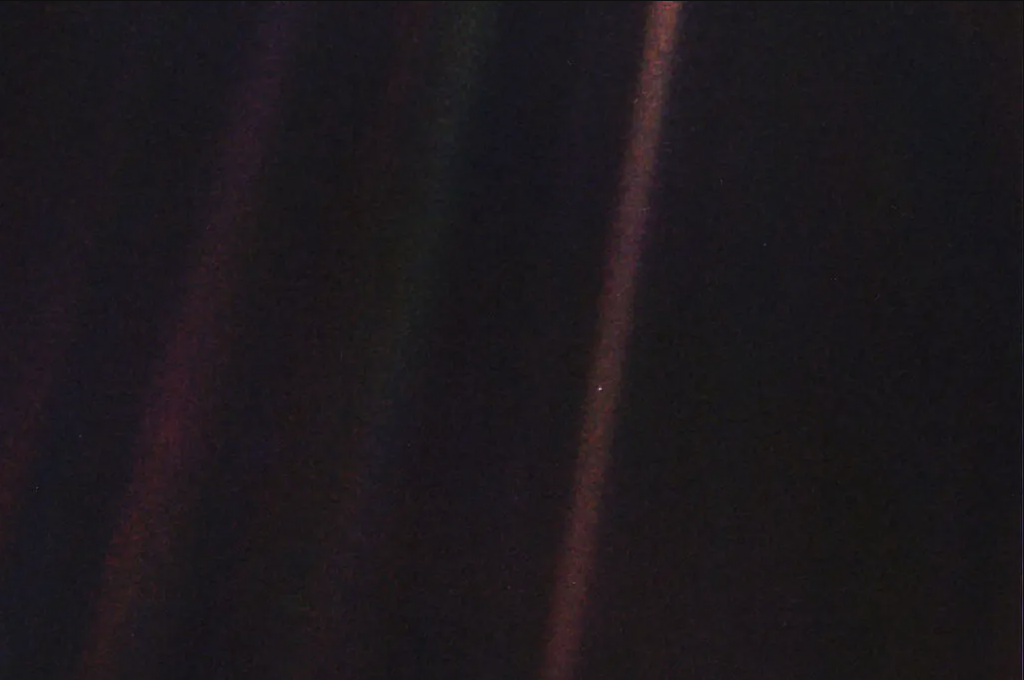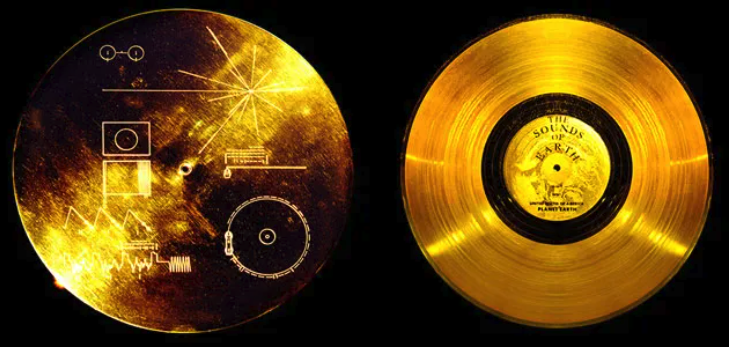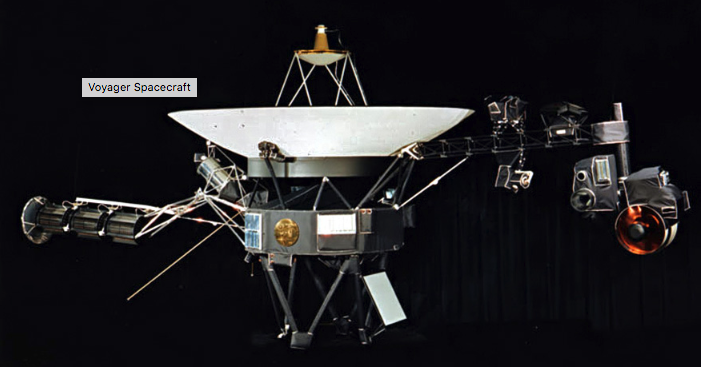
This psychedelic color view of Saturn from Voyager 2 reveals structure in the planet’s banded clouds: NASA/JPL-Caltech
The Big Picture –
By Glynn Wilson –
WASHINGTON, D.C. — Space exploration occupies some of my thoughts of late.
Wonder what’s become of Voyager 1? The first of its kind space probe launched in 1977 when I was right out of high school? Is it out there somewhere past Pluto, still transmitting?
This is the probe that took the famous photo of the Pale Blue Dot, Earth from interstellar space, and inspired the central appearance of V’ger or Voyager 6 in Star Trek: The Motion Picture.

The Pale Blue Dot is a photograph of Earth taken Feb. 14, 1990, by NASA’s Voyager 1 at a distance of 3.7 billion miles (6 billion kilometers) from the Sun: NASA/JPL-Caltech
Due to recent events in the news about computer technology and machine learning, commonly called Artificial Intelligence or AI, the Star Trek movie series seems appropriate viewing. The Max streaming service has them all. Some of the best science fiction thinkers and writers have already played out some of the most significant debates on the ethics and morality of it all, in lively and intense policy discussions. On deadline while facing life threatening consequences, at least on screen.
Related
Prepare Yourself for Battle With an Army of Bots
Someone at the New York Times science staff was also recently thinking about this.
It turns out all contact with Voyager 1 has been lost, according to NASA. It whizzes along at about 320 million miles a year out in interstellar space, between the stars, with a rock and roll message for any intelligent life in the universe.

The Golden Record consists of 115 analog-encoded photographs, greetings in 55 languages, a 12-minute montage of sounds on Earth and 90 minutes of music: NASA/NAJ screen shot
A gold record of “the Earth’s greatest hits,” as Carl Sagan once said in a televised show, which of course still lives on YouTube.
Perhaps most famous for its spectacular close up pictures of Jupiter and Saturn, the mission it was built for, Voyager 1 and a twin, Voyager 2, accomplished much more than that – with way less memory than the average smart phone, and with a radio transmitter with the power of one fridge light bulb.
Suzanne Dodd, Voyager mission project manager, said no coherent data has been received from Voyager 1 since November. It takes 45 hours for data to be received here. NASA engineers are still working on the problem, but the nuclear-powered generators of both spacecraft are expected to die in 2025 anyway.
“Scientifically, it’s a big loss,” Ms. Dodd said. “I think — emotionally — it’s maybe even a bigger loss.”
On the deepest journey into space so far of any human created spacecraft, Voyager 1 discovered moons, photographed planetary rings and active volcanoes, and stretched its expected life of four years into the infinite universe and is still going. It inspired a generation of space and science fans, including me.
“It’s known the world over, and it does connect humanity to the stars,” Dodd said of the mission. “I’ve had many, many many people come up to me and say: ‘Wow, I love Voyager. It’s what got me excited about space. It’s what got me thinking about our place here on Earth and what that means.’”
Could it perhaps one day still run into another intelligent civilization out there in the cosmos, capable of receiving and understanding the message?
Or will it encounter something like the cyborg civilization of The Borg, and reveal our location to the ultimate predator of OUR species?
Only time will tell.
It’s unclear, at least to me, how much time we have left as a species to find a way off this planet safely. Or if it is really even possible for humans to live in space for long?
But the science fiction depictions give us some things to think about, and some hope that it might one day be possible. If you are looking for a theme to come out of the Star Trek series, an answer to the questions: What does it all mean? Why are we here? Do we have a purpose? If so, what?
The answer, according to Captain Kirk, in his final words before passing to Captain Picard in Star Trek Generations, is: “Did we make a difference?”
“Yes, Captain. We made a difference.”
The problem is our looming deadlines.
Even if our species had smartened up or “woke” up 25 years ago and taken action on climate change due to global warming from the burning of fossil fuels for energy and transportation, the extremes in weather in the years from about 2034 to 2050 are going to create one long Hellscape anyway, according to projections, after the global population tops 9 billion. It reached 8 billion people in 2022.
There is some hope that enough will survive and some of the biggest problems might be solved after 2050, after the inevitable crashes in the population and the destruction of cities, coastal communities devastated by flood after flood, whole swathes of forests and rain forests burned to the ground, mass migrations and the inevitable economic instability and uncertainty.
Lucky for me, I most likely won’t be around that long to see it all go down anyway. Many of us Baby Boomers will be gone. Many already are gone, including some of my closest friends.
Some days we can all see some small signs of hope for our species.
Other days, not so much.
So much depends on the collective imagination and intelligence of human beings and how they communicate and work together toward a common mission and purpose.
Yet day after day, millions of people go along with a destructive narrative that seems to literally long for the day when it all comes to a fiery end in one magnificent nuclear Big Bang, with false hope that a god from heaven will intervene in the nick of time.
It would be nice to think a more intelligent and empathetic species may find Voyager as a cry for help, and come to our rescue. But that is not logical, or likely.
Only we can save ourselves. You, the people, have very little time. What are you going to do with it?
Thoughts and prayers?
Daily activism?
Or party like it’s 1929?
Drinks for my friends. Vinegar to the rest…
We do what we can do and let the rest go. We must find time and ways to enjoy what life we have left. Savor it. If you can. As it has been said many times, by many commentators over the centuries, life is indeed precious.














